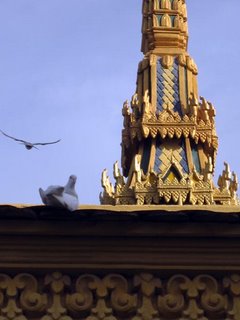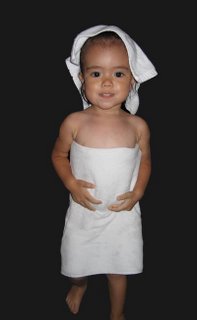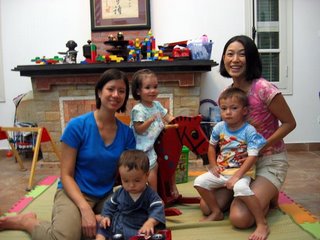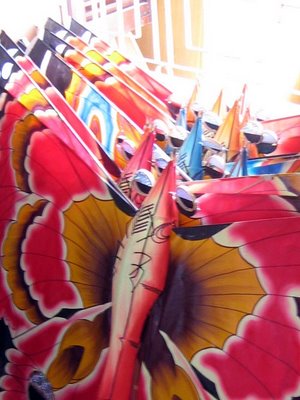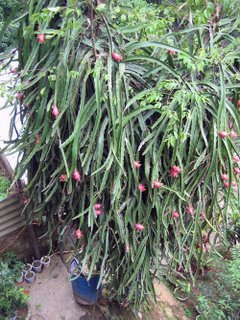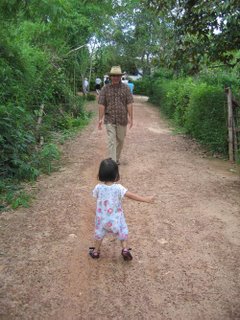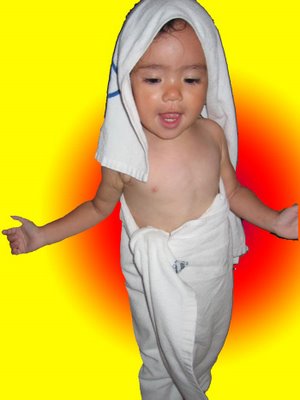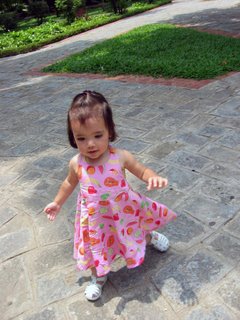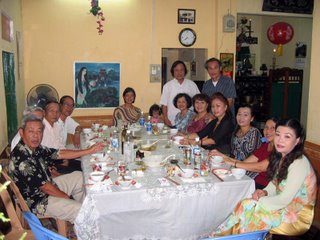 Ed Miller, an old friend from the Saigon Archives who now teaches at Dartmouth, came up to Hue last night for a weekend visit. Ed's writing a book on Ngo Dinh Diem and I think its going to be a hell of a history about an individual we still know relatively little about in the US, much less Vietnam where he is still considered by the current government as an American puppet (r. 1954-1963). Hong-Anh gave me leave this morning and we headed out via motorbike, just like the moto-taxi drivers and their Australian quarry in this picture at the hotel, for a morning of extreme tourism. Only, unlike these heavy-set oz-land burger munchers, we were heading far beyond the usual array of king's tombs and UNESCO world heritage sites to see some lesser known, unmarked monuments to the memory of the Ngo family who were originally from Hue. Diem's father, Ngo Dinh Kha, was actually the Chamberlain (prime minister) under the rebellious king Thanh Tai in the 1910's and he resigned his position in the Court of Hue after the French Resident Superior had the king deported for supposed crimes of perversion. Kha nevertheless was instrumental in establishing the famous National Academy highschool in Hue and his sons attended there in the 1920's.
Ed Miller, an old friend from the Saigon Archives who now teaches at Dartmouth, came up to Hue last night for a weekend visit. Ed's writing a book on Ngo Dinh Diem and I think its going to be a hell of a history about an individual we still know relatively little about in the US, much less Vietnam where he is still considered by the current government as an American puppet (r. 1954-1963). Hong-Anh gave me leave this morning and we headed out via motorbike, just like the moto-taxi drivers and their Australian quarry in this picture at the hotel, for a morning of extreme tourism. Only, unlike these heavy-set oz-land burger munchers, we were heading far beyond the usual array of king's tombs and UNESCO world heritage sites to see some lesser known, unmarked monuments to the memory of the Ngo family who were originally from Hue. Diem's father, Ngo Dinh Kha, was actually the Chamberlain (prime minister) under the rebellious king Thanh Tai in the 1910's and he resigned his position in the Court of Hue after the French Resident Superior had the king deported for supposed crimes of perversion. Kha nevertheless was instrumental in establishing the famous National Academy highschool in Hue and his sons attended there in the 1920's.
 Our first stop took us to a cathedral on a hill outside the downtown, the site for one of the first Catholic churches built in Hue after the French conquest of Indochina began - it was founded by a French priest in 1862. The old church was torn down in 1963 to make way for this huge, new modern one designed by a famous Vietnamese architect and then overseen by the Bishop of central Vietnam at the time, Diem's older brother Ngo Dinh Thuc. Thuc fled after Diem and his other brother Nhu's assassination in 1963 and lived in Rome for a while before he passed on.
Our first stop took us to a cathedral on a hill outside the downtown, the site for one of the first Catholic churches built in Hue after the French conquest of Indochina began - it was founded by a French priest in 1862. The old church was torn down in 1963 to make way for this huge, new modern one designed by a famous Vietnamese architect and then overseen by the Bishop of central Vietnam at the time, Diem's older brother Ngo Dinh Thuc. Thuc fled after Diem and his other brother Nhu's assassination in 1963 and lived in Rome for a while before he passed on.
 Besides learning a bit more about the church and Thuc, we got one of the kids at the church, a boy who hopes to become a priest when he is older, to guide us over to the tomb Ngo Dinh Diem had erected for his father after becoming President in 1955. Today, there is no sign for the tomb and the front gardens of this rather large tomb area are occupied by a steelworks yard in what seems to be a very carefully planned nod to Socialist realism. Still, nobody even questioned the two goofy foreigners waltzing past the reinforced steel rods and crawling over a delapidated fence to get a closer glimpse of father Kha's tomb. Curiously, after 1975 the graves of Kha's other son Ngo Dinh Can and a female relative were later exhumed and removed to Saigon next to NDD and NDN's graves in a more anonymous cemetary. We guess this is because NDK can still be seen as a kind fo influential patriot even in a history centered around the revolution.
Besides learning a bit more about the church and Thuc, we got one of the kids at the church, a boy who hopes to become a priest when he is older, to guide us over to the tomb Ngo Dinh Diem had erected for his father after becoming President in 1955. Today, there is no sign for the tomb and the front gardens of this rather large tomb area are occupied by a steelworks yard in what seems to be a very carefully planned nod to Socialist realism. Still, nobody even questioned the two goofy foreigners waltzing past the reinforced steel rods and crawling over a delapidated fence to get a closer glimpse of father Kha's tomb. Curiously, after 1975 the graves of Kha's other son Ngo Dinh Can and a female relative were later exhumed and removed to Saigon next to NDD and NDN's graves in a more anonymous cemetary. We guess this is because NDK can still be seen as a kind fo influential patriot even in a history centered around the revolution.
 From the relatively serene heights of this hill, we descended down a long slope towards the Tu Dam Pagoda where Ed took copious pictures of the large bodhi tree planted in the front yard in 1939. The tree had been brought here from India...nothing really tipped me off that this was significant until Ed explained that the Buddhist groups in Vietnam had lobbied for a long time under colonial rule to establish a national Buddhist church, and the French only relented in the 1940's as the Japanese invaded. Tu Dam Pagoda, the first center for the National Buddhist Sangha of Vietnam, then became a center for anti-Diem activity during the 1960's.
From the relatively serene heights of this hill, we descended down a long slope towards the Tu Dam Pagoda where Ed took copious pictures of the large bodhi tree planted in the front yard in 1939. The tree had been brought here from India...nothing really tipped me off that this was significant until Ed explained that the Buddhist groups in Vietnam had lobbied for a long time under colonial rule to establish a national Buddhist church, and the French only relented in the 1940's as the Japanese invaded. Tu Dam Pagoda, the first center for the National Buddhist Sangha of Vietnam, then became a center for anti-Diem activity during the 1960's.
 Following Tu Dam, we continued down the road a long ways until we got thoroughly lost in an area of hills south of town covered in cemetaries. This city of the dead was where all of the lesser types and their families were buried, the real people of Hue. It also happened to be where one of Diem's brothers lived, Ngo Dinh Can, a man who in the 1950's ran a kind of Abu Graib interrogation prison here. Imagine the effect riding past several kilometers of headstones would have on a prisoner... In 1940, the French anticipated a Japanese invasion of Indochina, so they built bunkers for storing weapons, including a network of them on a hill in this cemetary area. Can used these for his shady activities in the 1950's. Somewhat suspecting the locals here to be a little wary of dredging up these memories, we were a little bit cautious asking where the famous 9 bunkers (chin ham) were. However, every local, young and old seemed to know exactly where it was "just a little further!"
Following Tu Dam, we continued down the road a long ways until we got thoroughly lost in an area of hills south of town covered in cemetaries. This city of the dead was where all of the lesser types and their families were buried, the real people of Hue. It also happened to be where one of Diem's brothers lived, Ngo Dinh Can, a man who in the 1950's ran a kind of Abu Graib interrogation prison here. Imagine the effect riding past several kilometers of headstones would have on a prisoner... In 1940, the French anticipated a Japanese invasion of Indochina, so they built bunkers for storing weapons, including a network of them on a hill in this cemetary area. Can used these for his shady activities in the 1950's. Somewhat suspecting the locals here to be a little wary of dredging up these memories, we were a little bit cautious asking where the famous 9 bunkers (chin ham) were. However, every local, young and old seemed to know exactly where it was "just a little further!"
 With a few more stops, we finally came to a fork where government-installed roadside historical markers - the history nerd's homing beacons in stormy weather - appeared and guided us the last few kilometers down a muddy track.
With a few more stops, we finally came to a fork where government-installed roadside historical markers - the history nerd's homing beacons in stormy weather - appeared and guided us the last few kilometers down a muddy track.
After that, we found very little left of the actual bunkers, certainly nothing compared to WWII era bunkers one can crawl around in California or even Europe. My guess is that after 1968 or 69, this area was pretty solidly controlled by NLF guerillas and the US Airforce probably carpet-bombed the area as well as defoliating the hill with the bunkers.
 The reason, however, that so many people knew where the place was is that sometime a year or two ago, the government erected a massive memorial to the several hundred people who died in Can's interrogation/torture bunkers. It looks as if most of the bodies have been exhumed and then relocated across the way to this large temple. I actually find the socialist realist style stone carvings here to be quite tasteful, and the artistic representation of the bunker carvedinto the stele quite appropriate, minus the 6'5" white guy.
The reason, however, that so many people knew where the place was is that sometime a year or two ago, the government erected a massive memorial to the several hundred people who died in Can's interrogation/torture bunkers. It looks as if most of the bodies have been exhumed and then relocated across the way to this large temple. I actually find the socialist realist style stone carvings here to be quite tasteful, and the artistic representation of the bunker carvedinto the stele quite appropriate, minus the 6'5" white guy.
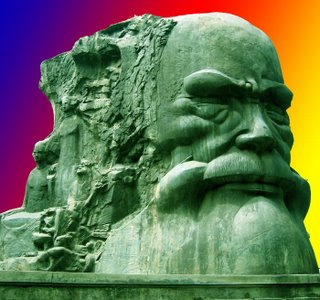 Did someone say tasteful socialist realist art? We briefly stopped after a delicious lunch with the Missus and Scuppy at the former house of Phan Boi Chau so Ed could take a picture of the ginormous bronze head representing the nation's historical marker to Phan Boi Chau. I think the idea is that Phan Boi Chau contributed some great ideas to Ho Chi Minh and especially Ngo Dinh Diem who hung out with Chau in the 1930's. Thank you, Chau, for your abnormally large brain. Why couldn't he also get a buff bod like so many other heroes? And why do there have to be so many faces and people trapped on the sides of your head like so many conjoined twins?
Did someone say tasteful socialist realist art? We briefly stopped after a delicious lunch with the Missus and Scuppy at the former house of Phan Boi Chau so Ed could take a picture of the ginormous bronze head representing the nation's historical marker to Phan Boi Chau. I think the idea is that Phan Boi Chau contributed some great ideas to Ho Chi Minh and especially Ngo Dinh Diem who hung out with Chau in the 1930's. Thank you, Chau, for your abnormally large brain. Why couldn't he also get a buff bod like so many other heroes? And why do there have to be so many faces and people trapped on the sides of your head like so many conjoined twins?
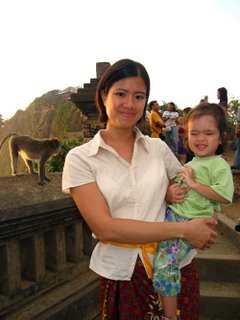 We're actually on our way out after one wonderful week on the island of Bali. We scheduled this from our free stopover on Singapore Air at Singapore. Got a cheap flight to Denpasar from SIN and then stayed at a resort we got on the internet for relatively cheap. While the food was nothing to write home about, the people and island life was amazing! Here Scuppy gives me her monkey face while one of the many primates hanging at Uluwatu Temple scope out sunglasses and watches ripe for the plucking. Uluwatu is one of the sacred points on the island, its southernmost point. Thus its also an incredible spot for waves, throwing up one of the world's best lefts. Pictured below is the new swell that just started coming in here yesterday and is ramping up today as we get on the plane to go home.
We're actually on our way out after one wonderful week on the island of Bali. We scheduled this from our free stopover on Singapore Air at Singapore. Got a cheap flight to Denpasar from SIN and then stayed at a resort we got on the internet for relatively cheap. While the food was nothing to write home about, the people and island life was amazing! Here Scuppy gives me her monkey face while one of the many primates hanging at Uluwatu Temple scope out sunglasses and watches ripe for the plucking. Uluwatu is one of the sacred points on the island, its southernmost point. Thus its also an incredible spot for waves, throwing up one of the world's best lefts. Pictured below is the new swell that just started coming in here yesterday and is ramping up today as we get on the plane to go home. Thanks especially for Jaya, Puji and Kai for showing us a great time this week in Bali! Jaya (Randall) is an American who has been living here for 10+ years. Jaya is an old surf buddy of (weathered) Alex (with Hanoi Hanh), and he took me out to a few spots with good faces on Wednesday and Thursday. This beach is Sanur and the sand is black from the volcanic runoff. In the distance is the little island of Lembongan. I'm happy to say I was inspired by the waves in Bali, though the fast tubular faces were a little much for my novice surfing self. Needless to say, I'm inspired to hit more waves in Cali upon our return and come back to Bali when I'm ready for some big barrels.
Thanks especially for Jaya, Puji and Kai for showing us a great time this week in Bali! Jaya (Randall) is an American who has been living here for 10+ years. Jaya is an old surf buddy of (weathered) Alex (with Hanoi Hanh), and he took me out to a few spots with good faces on Wednesday and Thursday. This beach is Sanur and the sand is black from the volcanic runoff. In the distance is the little island of Lembongan. I'm happy to say I was inspired by the waves in Bali, though the fast tubular faces were a little much for my novice surfing self. Needless to say, I'm inspired to hit more waves in Cali upon our return and come back to Bali when I'm ready for some big barrels. So, as the sun sets on Uluwatu, it also sets on our journey. We head back to Singapore then return to California tomorrow (Monday). Imagine our jet taking off across the seas to the sounds of gamelans and ukeleles...
So, as the sun sets on Uluwatu, it also sets on our journey. We head back to Singapore then return to California tomorrow (Monday). Imagine our jet taking off across the seas to the sounds of gamelans and ukeleles...



